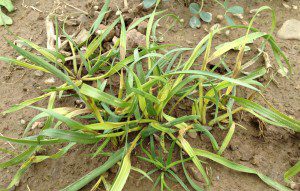From Mike Stanyard, Cornell Cooperative Extension: Water, Water, Everywhere
From 4 to 7 inches of water has fallen in most of WNY since June 6. This has resulted in ponded

and flooded fields that might result in some crop loss. How long can corn and soybeans survive under water? Answers vary but consensus is 2 to 4 days. If the temperature is in the mid 60’s, crops can survive up to 4 days if it is partially submerged. Survival time will be less if the average temperature is in the mid 70’s. Under warmer temperatures, plants will use their available oxygen up faster. So we want cloudy cool days instead of warmth and sun. Even when the water subsides, recovery will be slow as long as the soil remains saturated.
Replanting/Delayed Planting
What about replanting options? We are just about to the end of our planting window for NY. Many of these wet fields will take some time to dry out before they would be suitable to plant. Corn for grain is very risky at this point and even the shortest season hybrids would need a little luck to mature. We still have a very small window to get some corn for silage in the ground and still have it make it through. Soybeans can go in a little longer but the risk factor increases after June 20. I have seen soybeans planted as late as July 1 mature but it usually depends on good moisture in August and a warm fall.
From Bill Verbeten: Delayed/Frost Damaged Forages

Hay and haylage harvest has been delayed across western NY by the recent rains. Many farms have had to chop some of their silage back into the fields. For stands that haven’t had first cut taken off yet, the lower leaves have begun to fall off the alfalfa and it’s beginning to come into full flower while all grasses are headed out at this point. When the ground finally dries out these fields will have high tonnage of low quality feed. At this point we may lose our last cutting from this rain on some acreage. Just be thankful we didn’t have widespread winterkill—my home area of Wisconsin lost over 50% of their alfalfa to ice sheeting and eastern Ontario has lost over 75% of their hay and haylage ground. I have also seen some frost damage to grasses in new seedings (a dark, necrotic spot in the middle of leaves surrounded by yellow choloris—see picture “Frost Damaged Grass in New Seeding”). The new growth of this grass is green and the roots are undamaged so while it may look ugly, the grass will probably grow out of the frost damage in most cases.
Planting Emergency Forages: For those of you who need to plant something to feed to your cows on these flooded fields there are some options once they dry out (however if you claimed insurance you probably won’t be able to plant those acres until fall). Corn silage, sorghum, sorghum sudangrass, and hybrid pearl millet will be the highest yielding emergency forages—work from the University of Minnesota showed that 4-6 ton DM/acre (12-15 ton @ 35% DM/acre) was harvestable when planted the end of June/first week of July and 75-200 lbs./acre of nitrogen applied. We have a longer growing season in western New York than near the Twin Cities & Fargo, ND where this research was conducted so we should expect similar to potentially higher yields of these emergency forages. Forage soybeans will yield between 2-3 ton DM/acre. July planted oats with nitrogen fertilizer will only yield 1-2 ton DM/acre of silage. If you are considering planting an emergency forage, let me know and I can get you some more information.
Speak to an expert at King’s AgriSeeds now at 1-717-687-6224 or email us at [email protected].
